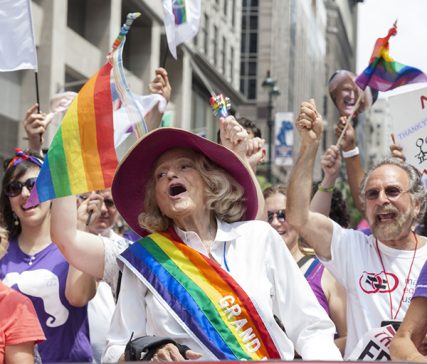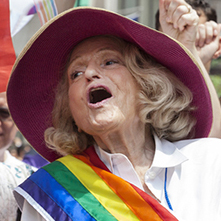(RNS) Edie Windsor turned 85 last week, but she was too “overdone” for a party.

Same-sex marriage pioneer Edie Windsor served as the grand marshal for the 43rd annual Pride Parade in Manhattan.
The woman whose lawsuit forced the federal government to recognize same-sex marriage introduced President Obama at a Democratic National Committee event a few nights earlier. A few nights later, she was to be introduced by former president Bill Clinton at an MTV “Trailblazers” event.
In between, there was the usual array of speeches, appearances and interviews that have taken over her life since June 26, 2013, when the Supreme Court ruled 5-4 in United States v. Windsor that the federal Defense of Marriage Act imposed “a disadvantage, a separate status, and so a stigma upon all who enter into same-sex marriages.”
That decision has influenced every court victory scored by the gay and lesbian community over the past 12 months — a remarkable string of 20 wins in a row that increased to 19 the number of states with same-sex marriage and put states as conservative as Texas and Utah on the defensive in federal appeals courts.
A judge in Oklahoma cited the Windsor ruling 65 times in his January ruling. Earlier this month, a judge in Wisconsin mentioned it 51 times. In all 20 rulings, the case has been cited more than 400 times.
Apart from propelling the judicial winning streak, the landmark case has extended Windsor’s 15 minutes of fame to a year and counting.
She is stopped on New York City’s street corners and subways, followed by filmmakers and photographers, honored with awards that accumulate on top of the harpsichord in her Greenwich Village apartment.
Emails still stream in from around the world — many of them from bi-national gay couples who faced immigration problems until the high court ruling made it easier for them to get green cards or apply for permanent immigrant status. Time magazine named her second-runner-up for 2013 Person of the Year, behind Pope Francis and Edward Snowden.
So on her birthday, Windsor called off the party and did what any girl would do. She went shopping.
“Since the decision, the victories in the state and federal courts all cite my case — ‘as according to Windsor,'” she said. “I know its not me but reference to the case — but I love it as if it were me.”
The love affair that produced the lawsuit remains at the center of Windsor’s life.
She was engaged for 40 years to Thea Spyer, perhaps New York’s most prominent lesbian psychologist. As Spyer’s physical condition worsened after three decades battling multiple sclerosis, the couple traveled to Toronto to get married in 2007. (The long courtship and marriage are celebrated on Windsor’s website, and in a documentary film, “Thea and Edie — A Very Long Engagement.”)
When Spyer died in 2009, leaving her estate to Windsor, she was socked with a $363,000 federal tax bill and about $275,000 more in state taxes. Estates that pass between husbands and wives aren’t taxed. To Windsor, that didn’t seem fair.
She hired Roberta Kaplan to take her case to court, and the rest is history. Today, the awards are piling up on Kaplan’s window ledge almost as quickly as the ones on Windsor’s harpsichord. Signed copies of their Supreme Court “red brief” have been auctioned for as much as $30,000 at gay-rights charity events.

A same-sex marriage supporter pays tribute to Edie Windsor’s contributions following the Supreme Court’s decision on DOMA in 2013.
“Truly, it’s stunning,” said Kaplan, 47, whose own same-sex marriage to Rachel Lavine now includes an 8-year-old son, Jacob. “She’s enjoying it, and you know what? She deserves it.”
For Windsor, the past year has included a State Dinner at the White House, an Oval Office meeting with the president and brunch with Michelle Obama at Kaplan’s home, where the first lady played hide-and-seek with Jacob.
There have been more invitations to serve as grand marshal at Pride parades than she can accept, from as far away as Iceland and Amsterdam. The past month often has included two or three events on the same day; after introducing President Obama last week, she went to a Brooklyn fundraiser for gay state court employees.
“For me, if I had to survive Thea, what a great life I have — full of love and community and joy,” Windsor said.
Despite appearing vivacious in public, Windsor is in failing health.
“I started the case in lousy shape,” she said, recalling the mild heart attack she experienced after Spyer’s death. She has an implantable cardioverter defibrillator and must build in time to rest between public events.
Luckily, she retains the “cottage” in Southhampton where she and Spyer spent summers, and where she hopes to spend August this year. The lesbian cruise line Olivia has given her a free pass, something she took advantage of twice over the winter.
Besides the glory, “she really feels a desire to give back,” Kaplan said — particularly by working with gay and lesbian youths stigmatized in the years before their homosexuality was taken for granted.
Windsor follows the progress of state and federal lawsuits across the country, often with the help of friends who relay the latest rulings. She fully expects the Supreme Court to make same-sex marriage legal nationwide — eventually.
“It may take some time to spread throughout the land, but it will happen,” she said.
In the meantime, life is a roller-coaster for the former IBM computer systems programmer-turned-gay-rights activist. For herself and millions of others, she said, the Supreme Court decision has meant more than marriage rights.
“The better we feel as citizens and as human beings — not ‘queers’ — the more of us come out,” Windsor said. “Our neighbors see us and our colleagues see us, and of course Americans, gay or straight, see us as people who live and love as they do, whose kids go to school and play with their kids. And it becomes still easier for us to be ourselves.”
(Richard Wolf writes for USA Today.)
YS END WOLF





